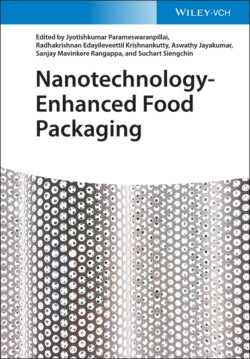Читать книгу Nanotechnology-Enhanced Food Packaging - Группа авторов - Страница 11
1.1 Introduction
ОглавлениеToday creating biodegradable and natural materials based on biodegradable food packaging materials is a major global challenge for the environment. However, the use of bio-based packaging products such as food grade or biodegradable films from recycled sources could address the problem of waste in at least some way. The correct choice of products and packaging technology thus enables consistency and freshness of products to be maintained over the time required to be promoted and used. Even though, the availability of bio-based food packaging is limited in the market due to its low gas barrier and mechanical properties. As a result, these natural polymers were frequently mixed or chemically modified with other synthetic polymers to expand their packaging applications. Bio-based packaging has many essential features, including traditional packaging, such as the preservation and securing of products, ensuring nutritional integrity and health, and providing awareness to the consumers. Another nanotechnology that may help to minimize waste from the processing of packaged food is the use of nanocomposites in the processing. The use of nanocomposites that seek to facilitate the use of biologically degradable films protects fresh food and enhances the durability of it.
Nanotechnology involves the manufacturing, manipulating, and characterizing of nanosized objects, particles, and materials with a dimension of approximately 1–100 nm. Although the size of the material is reduced to the nanoscale range, its physical and chemical properties are magnified greatly from those of the macroscale structures made of the same material. Consequently, the nanoscale (1–100 nm) systems may have some implications, but successful implementations of the same for serving mankind are invaluable. Nanotechnology provides a range of significant improvements to enhance health, stability, and quality of life and to create assertive impacts on the environment [1, 2].
The packaging systems are protective shields that secure, manage, transports, store, retains, and marks any entity in the supply chain from raw materials to end users. These functions are required to accurately define any type of packaging, and how a variety of requirements, such as mechanical, thermal, and barrier characteristics, are preserved depending on the type of products to be packaged. Nanomaterials are gradually being used in the food packaging industry; therefore a variety of advanced nanomaterial technology is being researched and developed for packaging materials. There have been studies of approximately 500 nano-packaging materials for industrial use, while nanotechnology is expected to manufacture 25% of all food packings. Nano-packaging can also conceive antimicrobials, minerals, enzymes, flavors, and nutraceuticals to enhance shelf life and performance. In this line, antimicrobial films are used as packaging material to improve the shelf life of perishable foods like fruits and dairy products [3–6].
Nanotechnology's potential role in the food technology sector is probably the most exciting in the immediate future, and it is emerging as one of the fastest developing areas of nano-research of agriculture and food. New developments in food processing, labeling, nutraceutical delivery, quality assurance, and healthy food have also been seen. Many organizations, scientists, inventors, and industries are developing new technologies, protocols, and products, which directly apply nanotechnology to farming and food products. Companies are now designing packaging materials that prolong food and beverage life and boost consumer safety through the use of nanotechnology in daily-based consumer packaging [6]. Food processing and control are the main subjects of food industry-related nanotechnology research and development. Effective and intelligent packaging is the leading advancement of food packaging that aims to enhance product quality and consistency as well as to maximize product longevity. Most businesses and industrial design nano-packaging like time–temperature indicators (TTIs) can react to undesirable or damaging changes under the worse effects of climatic pollution. They can self-repair themselves, thus making this nano-packaging as “active and smart packaging.”
Nanotechnology enhances the delivery of nutraceuticals, vitamins, or fragile micronutrients to everyday foods by creating small, edible capsules based on released nanoparticles to targeted locations in the body. Relevant health consequences are reduced frequency of cardiac disease, stroke, neurodegenerative diseases, and cancer [7, 8]. Nanoparticles are also used to introduce multiple functionalities such as color and odors as well as to be used as storage tanks for drug releases or fungicides. Despite considerable development in this area, nanotechnology remains a rare topic for food packaging, nanotechnology, and food science and technology. This chapter explores this knowledge gap by closely analyzing current developments in nano-package technology for food and drug systems and particular applications that gain immediate customer adoption and regulatory attention. This article examines this knowledge gap on the topics covered, which include bio-based packaging for environmentally safe biodegradable packaging; improved packages to enhance barrier properties, mechanical durability, and flexibility; active packaging of antimicrobials, flavor absorbers, and oxygen scavenging; and intelligent package features like freshness indicator, ripeness indicator, radio-frequency identification (RFID), and TTI. This chapter concludes with a concise overview of future nano-packaging technologies possibilities.
